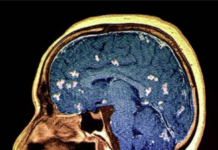Editor’s note: This blog originally appeared on Rai Waddingham’s Behind the Label.
 Last week I emerged from hibernation (life is a bit tough right now for lots of reasons) to attend a ‘Psychology at the Movies’ screening of 55 Steps – an important and hard-hitting film based on a true story of Eleanor Reise (a lady repeatedly drugged against her will, played by Helena Bonham Carter) and Collette Hughes (her lawyer, played by Hilary Swank) that has been effectively buried. What I write here is based on a series of tweets I made, trying to explain why we need to work together to resurrect it.
Last week I emerged from hibernation (life is a bit tough right now for lots of reasons) to attend a ‘Psychology at the Movies’ screening of 55 Steps – an important and hard-hitting film based on a true story of Eleanor Reise (a lady repeatedly drugged against her will, played by Helena Bonham Carter) and Collette Hughes (her lawyer, played by Hilary Swank) that has been effectively buried. What I write here is based on a series of tweets I made, trying to explain why we need to work together to resurrect it.
The opening scene was far more familiar than the 80s US asylum should be. Whilst our wards in the UK are often more modern and I’ve never seen someone tied to their bed, ‘physical restraint’ is very much alive & kicking. I have been bundled into seclusion, forced to the ground, had my pants pulled down & been injected with a drug that stole my will. I’ve felt humiliated, desperately needing a wee and being left for hours.
In response to Collette’s opening gambit of her being there to help, Eleanor said: ‘Everybody’s here to help me. That’s why I need help’. This cuts to the heart of it. Most people working in mental health want to ‘help’. Most family members agree to hospitalisation hoping it’ll ‘help’. Wider society is able to avert their eyes because good and kind people are trying to ‘help’. By framing restraint and forced drugging as an intervention to give treatment we have created a guided mask for what is essentially state-sanctioned GBH (Grievous Bodily Harm).
In almost any other situation, pinning people down and injecting them would be cause for investigations and criminal charges. The perpetrators would be seen as aggressors. Those who fought back would be seen as courageous. Those who accepted their fate would be understood. Against such odds, fighting back isn’t always the best option. Those who said they deserved such treatment, or that it was in their best interests, would be heard … but we would not send them back for more. We would draw a line.
We try not to draw comparisons with sexual assault, or allow ourselves to fully recognise or feel the profound degradation involved. We focus on the kindness and professionalism of the staff, the training provided, the illness of the person and that it is an intervention of last resort. We resort to the idea that lives are at risk if we do not act. That it is the only option available.
Yes – lives are at risk. Our lives. Systemising and reducing the risks of restraint only makes sense if we accept such coercion is necessary and ethical. It’s about making something less crap. It helps us feel better, but avoids the important dialogue – what do we need to do to stop this? How do we bring our mental health system back from the edge? How do we stop traumatising patients and staff in this way?
Investment, alternatives, attitude change, resourcing .. there’s much to be done. As long as we accept that holding people down to force them to take drugs is OK, will this change? It’s a plaster concealing a gaping wound that doesn’t cease to bleed just because we no longer have to look at it.
This might all sound dramatic – it is. It needs to be.
My experiences are mild comprised to many. I’m white, female and mostly related to coercion with compliance. I learned the game and the limits of my free will early into my journey. I was not Eleanor Reise. I did not call a lawyer and fight for the rights of me and my fellow patients. Together, her and Collette did something amazing. I want to celebrate that. It’s a tonic. I want to drink it in and feel that change is possible. That it’s possible to fight and win.
Eleanor died before this film was made. The impact of these drugs on her body was too much and, eventually, led to her early death. Despite the hard hitting realisation that the quality and length of people’s lives are at stake, this is not an anti-meds movie. It acknowledges that, even with informed choice, many would agree to take medication voluntarily. I think they would. But the concept of informed choice is key.
I re-started on Quetiapine last year after the birth of my baby. I know a lot about the drug. I knew it would probably help me (it does). I knew it’s possible adverse effects. I was not held down and forced to take it. I was not under a section. Yet, it was not a choice. Having been coerced in the past, I have always made a calculation about how far professions would let my decision to not take meds stand. The fact I could eventually be forced was a factor in my decision to agree. That is not true consent. It’s not choice. There was no other alternative. Now, a year later, I’m dealing with Tardive Dyskinesia – a topic featured in the film – and, yet again, withdrawing.
From the opening scene to its final thought, the film sets out the systematic dehumanisation of people diagnosed with ‘severe mental illness’ and the terrible cost borne by those who are deemed ‘mad’ and our society as a whole.
We need public will to fight again this and create the humane and ethical alternatives we need so badly. That takes money and rethinking our whole approach to supporting those in distress. Without a public outcry can you really imagine any government taking on such an initiative, especially as previous outcries have generally led to more coersion.
If you can, please check out 55 Steps. At the moment you can find it on Amazon Prime and Google Play.
Let yourself really feel what this treatment did to Eleanor and don’t avert your eyes. Value her strength, and the determination of her lawyer. Use that to stand up and say ‘NO’. Write to your MP. Write to your local mental health charities. Push for it to be screened in your local independent cinema. Tell any advocacy, patient experience, user-led, feminist, campaigning, legal, mental health, social justice, bird watching or social group you’re involved with about it. Group together and host a DIY screening, even.
Please do something. Don’t just watch it and go on with your lives. We are the ones who allow this to continue. We need to make our voices heard and let people know that this is not, in any way, mental health care.
Thank you to all those who arranged it, took part in the panel and allowed themselves to be affected by it. Including: Dr Sara Tai (Uni of Manchester), Prof. Peter Kinderman (Uni of Liverpool), Bryan Bonaparte (Uni of Westminster), Helena Bonham Carter CBE, Colette Hughes, Norman Lamb MP and Mark Bruce Rosin (the witer and producer of 55 Steps).






6 Comments Show Comments
I am sorry you have developed Tardive Dyskinesia. I hope the withdrawal goes OK and that the Tardive Dyskinesia lessons and if possible completely resolves.
Times 28-08-19
In 1961 a group of ordinary Americans were taken one by one into a laboratory and told to give someone an electric shock. This they duly did, listening in as their victim screamed and convulsed in agony in another room.
The moral of this, which became probably the most famous psychology experiment in history, was clear: people will do something monstrous because an authority figure told them to.
That, at least, is the common interpretation of the Milgram experiment, which has been used to explain atrocities ranging from the Holocaust to the Rwandan genocide. But a previously unpublished analysis suggests an alternative, simpler explanation: a lot of people guessed that the whole thing was a sham.
The analysis, based on questions to the subjects afterwards, suggests that the efforts of Stanley Milgram, the Yale psychologist, to convince people that they really were causing pain were less effective than he admitted. Not only did half of those involved doubt to some degree that they were administering a shock but the data also showed that their level of belief directly affected their behaviour.
According to an analysis published in Social Psychology Quarterly, the more certain people were that the experiment was real, the lower the shock they gave. Tellingly, most of those who were convinced that they were torturing someone defied orders and quit the experiment. Far from being monsters, they chose the moral course of action.
Even at the time when Milgram published the his results, along with claims about what they showed about human nature, his fellow psychologists questioned their validity.
Milgram was robust in his response. “[With] few exceptions subjects were convinced of the reality of the experimental situation,” he wrote. Such was the distress among those who took part caused by fighting the competing urge on the one hand to obey and on the other to stop pain that one “poised businessman” was “reduced to a twitching, stuttering wreck”.
Partly because of the attacks of Milgram’s peers he also commissioned a questionnaire, to follow up with those involved and assess their level of belief. Its findings, not published in full at the time, tell a different story.
Gina Perry, from the University of Melbourne, was one of those involved in the reanalysis. She has been investigating the Milgram experiment since writing a book in 2012. In the course of researching it she found evidence that the experiment, cited in textbooks worldwide, had significant flaws.
She said it was unsurprising that many doubted the setup. This was the time of the Candid Camera television shows, which used hidden cameras. Her research found that people were suspicious that the cheque given to the victim as “payment” was dog-eared and apparently used many times, that the cries seemed to come from a speaker and “the unlikelihood of Yale conducting an experiment involving torture”.
The unpublished questionnaire, she said, provided evidence that these doubts should have been a significant corrective to any sweeping conclusions. “Our analysis offers little support for the theory that Milgram’s subjects, despite the usual dictates of conscience, became inattentive functionaries who inflicted painful shocks against an innocent person indifferent to the resulting consequences,” Dr Perry writes.
“The majority of subjects perceived that the learner was suffering and defied the experimenter. Those who were less successfully convinced by the cover story were more obedient.”
If there were a moral to the Milgram experiment then, it may be less about people’s capacity for inhumanity than about scientists’ capacity for self-delusion in the cause of a pet theory.
God bless. Had a similar experience, now trying to get my mind back after years of forcing ‘medication’ on me. ‘For God have not given us the spirit of fear; but of power, and of love, and of a sound mind.’ – 2 Timothy king James Bible.
Thank you. MITUK Admin. Will act on this information and share as widely as possible.
Is 55 Steps available for us to buy in the UK please?
The post, and the trailer are very moving. Thank you.
Dear Retired Physician. Thank you for your message. 55 can Steps can be purchased online from:
Amazon UK https://www.amazon.co.uk/55-Steps-Hilary-Swank/dp/B07JCJ6X5S
Amazon US https://www.amazon.com/55-Steps-Hilary-Swank/dp/B07JVR24ZL
Apple iTunes https://itunes.apple.com/gb/movie/55-steps/id1436378921
Sky Store https://www.skystore.com/product/55-steps/c7b695c4-c125-41a6-92c6-fa4a5956b32b
There doesn’t seem to be a Blu Ray or DVD available yet, but I will keep looking.